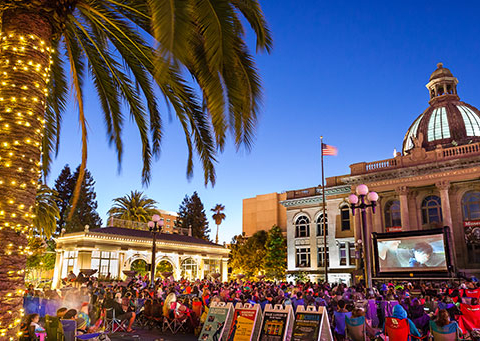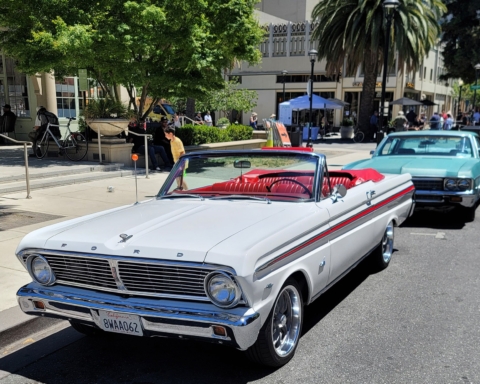The Glue of Friendship for these “Solitary” Collectors
By Bill Shilstone
To some, stamp collecting may seem a somewhat anti-social exercise. Poring over catalogs in search of an elusive prize. Meticulously organizing an album or two –or two hundred.
For members of the Sequoia Stamp Club, it’s more an excuse to party.
The club is just getting over its biggest party of the year, the annual Peninsula Philatelic Exchange (PENPEX) at the Redwood City Community Activities Building, where part of the fun is swapping stamps, and stamp stories. At the PENPEX show Dec. 2 and 3, there were plenty of both to be seen and heard in the Silent Auction Room, Exhibit Hall and the Stamps R Us Beginners Room.
At the auction, where the high bid was $350 for a worldwide collection of 5,600 early 20th century stamps, Jim Giacomazzi and club president Chris Palermo were discussing the world’s most valuable stamp, the British Guiana 1-cent magenta. Only one remains of the few made by special request in 1856. It last sold for $9.4 million and once was owned by convicted murderer John du Pont. (That reminded Giacomazzi of the stamp-collecting hit man in Lawrence Block’s novels who likes to relax with his collection after a particularly stressful assassination.)
The Sequoia club’s interests are more down-to-earth. Despite a sharp decline in the number of American Philatelic Society members in the Internet and email era, the Sequoia club remains vibrant because of its focus on picnics, pizza parties and other social activities, Palermo said. He and other well-traveled collectors and dealers at the show agreed that the Sequoia club is one of the healthiest they’ve seen, with at least 40 of its 100 members turning out for the twice-monthly meetings.
Many members have the same answer for why they collect – for the fun of it. “I’ve never met a member of the club I didn’t like,” said Eduardo Martino of San Carlos, who started in his native Argentina collecting soccer-star stamps. But there is also what Martino called “the thrill of the hunt for that missing piece.” Each meeting includes a member-supplied silent auction that just might have it. Socializing, snacking and a speaker on topics philatelic also are part of the meetings.
In the Exhibit Hall, David McNamee of Walnut Creek, who was one of the judges, told what he looks for. “I collect knowledge,” McNamee said. “I want to learn something.” He gave as an example an exhibit on scented stamps that taught him exactly how the aromas – coconut, chocolate, banana – are applied.
He and his fellow judges awarded one of the top prizes to that exhibit, by “Pepe LePew” (otherwise anonymous, in keeping with the fun-and-games flavor of the group). The 66 entries, mounted on large frames, were full of intricate artwork and lessons in history and geography. Another award, presented by the Northern California Council of Philatelic Societies, was to the show’s chairperson Kristin Patterson for her support of local clubs.
Most collections are thematic, such as Giacomazzi’s albums on Venezuela, where he served in the Peace Corps, and basketball, which he coached at San Carlos High School in the 1970s. Ed Rosen, the club’s senior member (since 1965), collects stamped envelopes, some canceled by hand, mailed from Redwood City, Woodside and Searsville from the 1850s to 1900.
He started collecting as an 8-year-old in San Francisco. “We didn’t have television, but we had a lot of foreign neighbors who got mail,” he said. “I steamed off the stamps.”
Richard Clever, a dealer specializing in Asia, said he got his start when an Army Air Forces friend of his father’s who flew “The Hump” over the Himalayas in World War II presented a supply of China stamps that quickly passed to young Richard. Palermo, who specializes in narrow-gauge railways, said the Internet may be robbing the post office of revenue, but it also makes it easy to locate and identify stamps.
In the Youth Room, 95-year-old Richard Coleman told one of the 325 visitors to the show that he got hooked on stamps at age 7 when his family was living in a hotel and “the lady next door said if I was quiet she would give me stamps.” While three first- and second-graders soaked stamps off of envelopes and sifted hundreds of loose singles by the handful, Coleman’s fellow docent, Preston Chiappa, explained how the club attracts new blood to an aging membership.
“We have 30 members in the youth and beginner group,” he said. “For $5 per month, new members get an ounce of stamps (300) every month, and twice a year we give them albums and hinges for mounting.” The club annually awards a $500 scholarship to a Sequoia High School student with a good academic record and an interest in collecting (anything).
The club grew out of stamp clubs at Sequoia High dating back to 1927. Officially, the club was born in 1947 and so has just finished celebrating its 70th anniversary. Its first members gathered at the firehouse at Jefferson Avenue and Myrtle Street and made city recreation director Alfred “Red” Morton its first honorary member for his efforts in promoting the club and providing supplies.
As the club grew, it moved to larger quarters, first the YMCA building on Brewster Avenue, later to the Veterans Memorial Building, and in 1967 to its present home at the Community Activities Building at Red Morton Park on Roosevelt Avenue. Dues were $1 a year in the beginning, and now have inflated to $3. Giacomazzi said the club is financially healthy. Rent paid to the city is minimal, the club takes a 10 percent cut on its auction sales, and members are generous in donating and bequeathing collections. The club makes donations to community-building organizations including Samaritan House, St. Anthony’s Dining Room and the Redwood City Library Foundation.
“It’s not a profit motive for us,” Giacomazzi said. “It’s for fun.” He has a huge collection and a store of stamp knowledge to match. The first U.S. stamps were issued in 1847, all with images of either Benjamin Franklin or George Washington until Thomas Jefferson appeared in 1856. In 1893 commemoratives arrived, and today “Young Elvis” is the best-selling U.S. stamp, Giacomazzi said.
“You can be as sophisticated and involved as you wish,” he said, “focusing on tiny details regarding perforation or unperforation and water marks. The Scott catalog, the bible of stamp collecting, lists and illustrates (in eight thick volumes) all that have ever been issued (countless), with estimated values. Mint condition is essential to some collectors, but I like stamps that have done their job.”
“My story is typical,” he continued. “Started young and picked it up again later in life when I had the time. What’s the attraction? Somebody said, and I think it’s true, that some people are born with ‘organizing’ genes. If your life is chaotic, here is one part that will be organized.”






